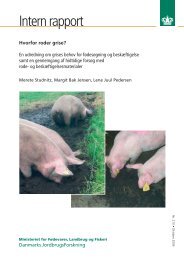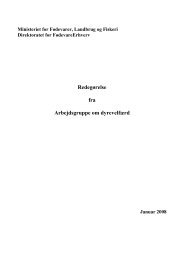Forekomst af antikoagulante rodenticider i danske rovfugle, ugler og ...
Forekomst af antikoagulante rodenticider i danske rovfugle, ugler og ...
Forekomst af antikoagulante rodenticider i danske rovfugle, ugler og ...
You also want an ePaper? Increase the reach of your titles
YUMPU automatically turns print PDFs into web optimized ePapers that Google loves.
10<br />
aeruginosus and 3.0 in eagle owl Bubo bubo. Overall more than 60% of<br />
birds and 80% of mustelids had two or more anticoagulants in their body.<br />
For the kestrel Falco tinnunculus, common buzzard Buteo buteo, tawny<br />
owl, barn owl Tyto alba and little owl Athene noctua the average cumulative<br />
concentration of all anticoagulants in the liver ranged between 35<br />
and 58 ng/g. For the red kite Milvus milvus and the eagle owl, the average<br />
concentration was 152 and 162 ng/g, respectively, while concentrations<br />
in rough-legged buzzard Buteo lagopus, marsh harrier, long-eared<br />
owl Asio otus and short-eared owl Asio flammeus ranged between 9 and<br />
24 ng/g. There was no obvious explanation for the observed differences,<br />
but these may be due to the degree to which the species exploit urbanised<br />
areas and farmland. The higher concentrations in red kite and eagle<br />
owl may relate to their predation of carrion and rats, respectively. The<br />
average concentrations of anticoagulant rodenticides in stoat Mustela nivalis<br />
and weasel Mustela erminea were 58 and 63 ng/g, respectively. The<br />
highest levels of anticoagulants were measured in stoats and weasels.<br />
Studies suggest that 200 ng/g anticoagulants in the liver represent a critical<br />
contamination level for raptors and owls. Between 5.7% and 22% of<br />
the examined kestrel, common buzzard, tawny owl, barn owl, little owl,<br />
stoat and weasel had concentrations higher than 200 ng/g. Amongst red<br />
kite and the eagle owl the proportion of individuals with more than 200<br />
ng/g liver were 66% and 70%, respectively, while there were no critically<br />
high concentrations recorded in rough-legged buzzard, marsh harrier,<br />
long-eared owl and short-eared owl, although small sample size for the<br />
last species prevents firm conclusions.<br />
Overall no differences in frequency and level of contamination were detected<br />
between sex and age groups, between time of year, or in relation<br />
to the registered cause of death, which could indicate a systematic pattern<br />
in the risk of poisoning. For stoat and weasel, concentrations of anticoagulants<br />
increased from spring to winter, a trend reflected amongst<br />
some of the bird species. Higher concentrations were also present in<br />
stoats and weasels found dead, compared to other causes of death, and<br />
for both species, body condition were weakly, but significantly correlated<br />
with rodenticide burdens.<br />
The recorded frequencies of anticoagulant poisoning in Danish birds of<br />
prey, owls and mustelids, were markedly higher for most species than<br />
those from British studies. The number of anticoagulants recorded per<br />
individual was also higher in Danish birds and mustelids than found in<br />
Great Britain. Higher sensitivity of the HPLC analysis used in the present<br />
study cannot explain this difference. Possible explanations for the<br />
differences between Denmark and Great Britain may include differences<br />
in landscape structure, in application policies and methods for authorized<br />
rodent control and in private use of the anticoagulants available on<br />
the open market.<br />
The use of anticoagulants over the past 10-20 years to control rodents in<br />
Denmark has not had any documented adverse effect on the populations<br />
of raptors and owls, as most species have increased in abundance during<br />
this period. However, it can not be ruled out that the use of anticoagulants<br />
locally or even nationally has elevated chick mortality in some




